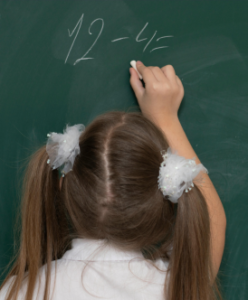3rd Grade Math Struggles?
Here is How to help
by Ash Kirkland
If your child is having a tough time with math this year, you’re not alone. According to the School Pulse Panel, 40% of public-school students started the 2024–25 school year behind grade level in at least one subject. Math, in particular, can become challenging in 3rd grade as students are introduced to new and more complex concepts.

Common Challenges in 3rd Grade Math
Third grade marks a big leap in math skills, especially with the introduction of multiplication and fractions. These concepts are very different from the basic addition and subtraction students have been learning up until now, making them tricky to grasp at first. Here’s a breakdown of common struggles and why they happen.

Multiplication and Division Struggles
By 3rd grade, students are expected to memorize multiplication facts up to 10 × 10, which is no small task. If they haven’t built fluency, solving word problems and multi-step equations can feel overwhelming. Division adds another layer of challenge. It’s the first time many kids are seeing it, and understanding that division is just multiplication in reverse can be tricky at first.
Word Problems and Comprehension
For many kids, math struggles aren’t just about numbers. They are about reading comprehension too. Word problems require students to pull out key information and decide which operation to use, which isn’t always easy. Multi-step and multiple-choice word problems can feel especially frustrating. If a child is below grade level in reading, lacks confidence in decision-making, or experiences math anxiety, these problems can feel impossible to tackle.
Fractions and Number Sense
Fractions introduce a whole new way of thinking about numbers. Understanding that 1/2, 1/3, and 1/4 represent parts of a whole is one thing, but comparing fractions or placing them on a number line is another challenge. Most kids do fine when fractions are shown visually, like a shaded circle or rectangle. When those visuals disappear, imagining what a fraction looks like can be really tough.

Place Value and Large Numbers
Third graders start working with four-digit numbers and learning how to break them down. For example, 4,356 = 4,000 + 300 + 50 + 6. That is a big jump from the smaller numbers they have been used to. Rounding is another common struggle. Many kids automatically round up instead of thinking through the rules, which leads to mistakes. After a few wrong answers, they start doubting themselves, and that lack of confidence makes it even harder.
Telling Time and Elapsed Time
Reading an analog clock is becoming a lost skill in the digital age, so it’s no surprise that many 3rd graders struggle with it. Figuring out elapsed time, like how much time passes between 10:15 AM and 11:45 AM, is even harder. This is usually more of a sign of the times than a reflection of a child’s math ability.

How to Support Your Child in Math
Third grade is often when kids start experiencing math anxiety, and it’s no surprise why. There are fewer visuals, familiar concepts start shifting, and word problems become more complex. The good news is that you can help your child build confidence in math with a few simple strategies.
Spend Time With Them
It sounds simple, but one of the best ways to support your child is just being present. Sit with them while they do homework, talk about what they are learning, and let them show off their new skills. Knowing you are interested helps them feel more secure and boosts their confidence.
Lead, Don’t Do, When Helping With Homework
It’s tempting to show your child how to solve a problem, but if you do too much, they don’t get a chance to figure it out themselves. Instead, guide them to the answer by asking questions and encouraging their thought process. This helps them gain independence while also giving you insight into where they might be struggling. Plus, it keeps them aligned with how they are being taught in class.

Stay in Touch With Their Teacher
It’s easy to rely on report cards and conferences to track progress, but if you notice your child struggling, don’t wait. Reach out to their teacher. If helping at home feels challenging, you can ask:
- What specific methods are they using in class?
- Are there answer keys available for homework if needed?
- What extra support or resources are available?
Teachers are there to help, and getting on the same page with them can make a huge difference in how your child approaches math.
Make Math a Part of Everyday Life
Math isn’t just for the classroom. It’s everywhere. Help your child see it in action by looking for real-world opportunities.
- Cooking: Have them measure ingredients or double a recipe.
- Shopping: Let them calculate change or compare prices.
- Time-telling: Use an analog clock to reinforce elapsed time.
Playing math-related games like card games, board games, or puzzles can also make learning fun and reinforce key skills without feeling like schoolwork.

Normalize Mistakes as Part of Learning
Struggling with math doesn’t mean your child isn’t good at it. It just means they are learning. Help them see mistakes as part of the process rather than something to be afraid of.
Instead of focusing only on right answers, praise their effort with phrases like:
✅ “I love how you kept trying!”
✅ “That was a tricky one, but you did great!”
This helps build resilience and confidence so they are more willing to tackle challenges instead of shutting down.
Actions Your Child Can Take
Here are some simple but effective ways your child can boost their math skills, stay engaged, and build confidence in what they are learning.

Use Flashcards
Flashcards are a fantastic tool for this age group, especially for multiplication and division. You can find pre-made flashcards at most stores that carry school supplies like Walmart, Office Depot, or Amazon. Making your own at home can also be a fun project to do together.
Ditch the Multiplication Chart
Many teachers allow students to use multiplication charts, but relying on them too much slows down memorization. If your child is working on multiplication or division at home, encourage them to solve problems by memory instead of constantly checking a chart. This helps build fluency and makes future math work much easier.
Bring Home All Materials
A common struggle is kids leaving their homework, textbooks, or graded assignments at school. Encourage your child to double-check their backpack before leaving class so they have everything they need to practice at home.
Read Word Problems Out Loud
Reading out loud can help with both math and reading comprehension. If a child struggles with silent reading, tricky words can throw off their understanding of the entire problem. Have them read word problems out loud. This reinforces their understanding and improves pronunciation at the same time.
Slow Down and Check Their Work
Let’s be honest. Kids rush through homework just to get it done. While we all can relate, this often leads to careless mistakes. Remind your child to take their time and double-check their work before turning it in. Getting into this habit early will pay off in the long run.

Math in third grade can be tough, but with the right support, kids can gain confidence and improve their skills. Whether it’s spending time with them, making math part of daily life, or simply encouraging them to slow down and check their work, small efforts can make a big difference.

